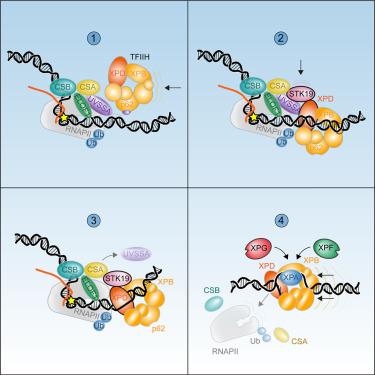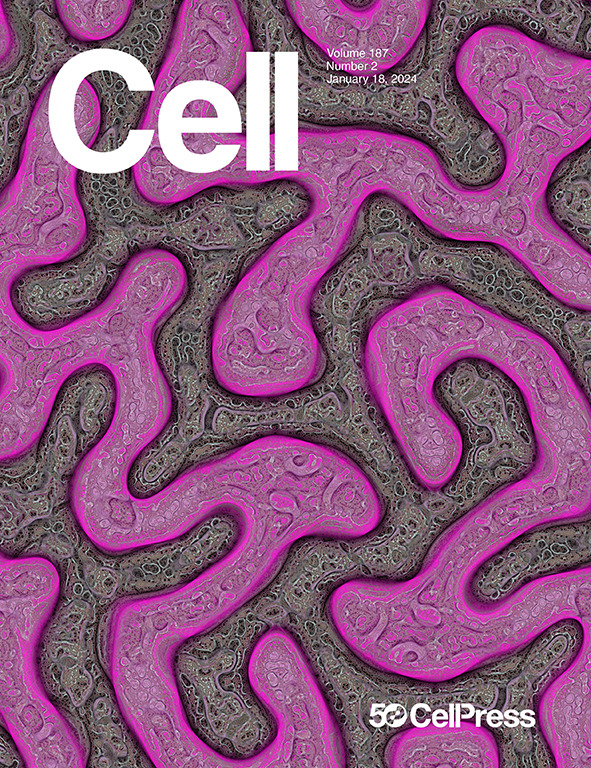STK19 facilitates the clearance of lesion-stalled RNAPII during transcription-coupled DNA repair
IF 45.5
1区 生物学
Q1 BIOCHEMISTRY & MOLECULAR BIOLOGY
引用次数: 0
Abstract
Transcription-coupled DNA repair (TCR) removes bulky DNA lesions impeding RNA polymerase II (RNAPII) transcription. Recent studies have outlined the stepwise assembly of TCR factors CSB, CSA, UVSSA, and transcription factor IIH (TFIIH) around lesion-stalled RNAPII. However, the mechanism and factors required for the transition to downstream repair steps, including RNAPII removal to provide repair proteins access to the DNA lesion, remain unclear. Here, we identify STK19 as a TCR factor facilitating this transition. Loss of STK19 does not impact initial TCR complex assembly or RNAPII ubiquitylation but delays lesion-stalled RNAPII clearance, thereby interfering with the downstream repair reaction. Cryoelectron microscopy (cryo-EM) and mutational analysis reveal that STK19 associates with the TCR complex, positioning itself between RNAPII, UVSSA, and CSA. The structural insights and molecular modeling suggest that STK19 positions the ATPase subunits of TFIIH onto DNA in front of RNAPII. Together, these findings provide new insights into the factors and mechanisms required for TCR.

STK19 在转录耦合 DNA 修复过程中促进清除病变停滞的 RNAPII
转录耦合 DNA 修复(TCR)可清除阻碍 RNA 聚合酶 II(RNAPII)转录的大块 DNA 病变。最近的研究概述了 TCR 因子 CSB、CSA、UVSSA 和转录因子 IIH(TFIIH)围绕病变停滞的 RNAPII 逐步组装的过程。然而,过渡到下游修复步骤(包括移除 RNAPII 以提供修复蛋白进入 DNA 病变)所需的机制和因子仍不清楚。在这里,我们发现 STK19 是促进这一过渡的 TCR 因子。STK19 的缺失不会影响最初的 TCR 复合物组装或 RNAPII 泛素化,但会延迟病变停滞的 RNAPII 清除,从而干扰下游修复反应。低温电子显微镜(cryo-EM)和突变分析表明,STK19 与 TCR 复合物结合,位于 RNAPII、UVSSA 和 CSA 之间。结构洞察和分子建模表明,STK19 将 TFIIH 的 ATPase 亚基定位在 RNAPII 前面的 DNA 上。这些发现共同为 TCR 所需的因素和机制提供了新的见解。
本文章由计算机程序翻译,如有差异,请以英文原文为准。
求助全文
约1分钟内获得全文
求助全文
来源期刊

Cell
生物-生化与分子生物学
CiteScore
110.00
自引率
0.80%
发文量
396
审稿时长
2 months
期刊介绍:
Cells is an international, peer-reviewed, open access journal that focuses on cell biology, molecular biology, and biophysics. It is affiliated with several societies, including the Spanish Society for Biochemistry and Molecular Biology (SEBBM), Nordic Autophagy Society (NAS), Spanish Society of Hematology and Hemotherapy (SEHH), and Society for Regenerative Medicine (Russian Federation) (RPO).
The journal publishes research findings of significant importance in various areas of experimental biology, such as cell biology, molecular biology, neuroscience, immunology, virology, microbiology, cancer, human genetics, systems biology, signaling, and disease mechanisms and therapeutics. The primary criterion for considering papers is whether the results contribute to significant conceptual advances or raise thought-provoking questions and hypotheses related to interesting and important biological inquiries.
In addition to primary research articles presented in four formats, Cells also features review and opinion articles in its "leading edge" section, discussing recent research advancements and topics of interest to its wide readership.
 求助内容:
求助内容: 应助结果提醒方式:
应助结果提醒方式:


